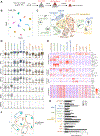Clonal lineage tracing reveals shared origin of conventional and plasmacytoid dendritic cells
- PMID: 35180378
- PMCID: PMC9344860
- DOI: 10.1016/j.immuni.2022.01.016
Clonal lineage tracing reveals shared origin of conventional and plasmacytoid dendritic cells
Abstract
Developmental origins of dendritic cells (DCs) including conventional DCs (cDCs, comprising cDC1 and cDC2 subsets) and plasmacytoid DCs (pDCs) remain unclear. We studied DC development in unmanipulated adult mice using inducible lineage tracing combined with clonal DNA "barcoding" and single-cell transcriptome and phenotype analysis (CITE-seq). Inducible tracing of Cx3cr1+ hematopoietic progenitors in the bone marrow showed that they simultaneously produce all DC subsets including pDCs, cDC1s, and cDC2s. Clonal tracing of hematopoietic stem cells (HSCs) and of Cx3cr1+ progenitors revealed clone sharing between cDC1s and pDCs, but not between the two cDC subsets or between pDCs and B cells. Accordingly, CITE-seq analyses of differentiating HSCs and Cx3cr1+ progenitors identified progressive stages of pDC development including Cx3cr1+ Ly-6D+ pro-pDCs that were distinct from lymphoid progenitors. These results reveal the shared origin of pDCs and cDCs and suggest a revised scheme of DC development whereby pDCs share clonal relationship with cDC1s.
Keywords: conventional dendritic cells; hematopoietic progenitors; hematopoietic stem cells; lineage tracing; plasmacytoid dendritic cells.
Copyright © 2022 Elsevier Inc. All rights reserved.
Conflict of interest statement
Declaration of interests M.S. and P.S. are inventors on a patent related to the CITE-seq method. They are current employees of 10x Genomics, Inc. but were not affiliated with it or any other commercial entity at the time of the work described in this manuscript. B.R. is an adviser for Related Sciences and a co-founder of Danger Bio, which are not related to this work. Other authors declare no competing interests.
Figures







Comment in
-
Plasmacytoid dendritic cells: Welcome back to the DC fold.Immunity. 2022 Mar 8;55(3):380-382. doi: 10.1016/j.immuni.2022.02.011. Immunity. 2022. PMID: 35263562
References
Publication types
MeSH terms
Supplementary concepts
Grants and funding
LinkOut - more resources
Full Text Sources
Other Literature Sources
Molecular Biology Databases
Research Materials
Miscellaneous

